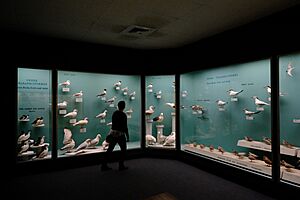Peabody Museum of Natural History facts for kids

(2024)
|
|
| Lua error in Module:Location_map at line 420: attempt to index field 'wikibase' (a nil value). | |
| Established | 1866 |
|---|---|
| Location | New Haven, Connecticut, US |
| Type | |
| Owner | Yale University |
| Public transit access | |
The Peabody Museum of Natural History at Yale University is one of the oldest and largest natural history museums connected to a university anywhere in the world. It was started by a kind person named George Peabody in 1866. He did this because his nephew, Othniel Charles Marsh, who studied ancient life (a paleontologist), asked him to.
The museum is famous for its Great Hall of Dinosaurs. This hall has a huge Brontosaurus skeleton and a very long painting called The Age of Reptiles. The museum also has exhibits about how humans and other mammals have changed over time. You can see displays of wildlife in their natural homes (called dioramas), ancient Egyptian objects, local birds and minerals, and items from Native American tribes in Connecticut.
The Peabody Museum closed in 2020 for a big update, its first major renovation in 90 years. It reopened on March 26, 2024, with much more space for exhibits.
Contents
What is the Peabody Museum?
The Peabody Museum is located at 170 Whitney Avenue in New Haven, Connecticut. Many people work there to keep it running. The first museum building was taken down in 1917. The museum then moved to its current spot in 1925. Since then, it has grown to include other buildings and even a special field station near Long Island Sound. The museum also owns Horse Island, which is used for scientific experiments and is not open to the public. About half of the museum's 13 million specimens are kept in the Class of 1954 Environmental Science Center, which was finished in 2001.
In 2018, a very generous gift of $160 million from Edward P. Bass helped pay for the museum's big renovation. This was one of the largest gifts ever given to a natural history museum in the United States.
The museum's galleries were supposed to stay open until June 2020, but they had to close early in March 2020 because of COVID-19. They stayed closed until the renovations were finished in 2024. The renovation more than doubled the space for exhibits. It also added 10 new classrooms and a special education center for students from kindergarten to 12th grade.
In November 2021, Yale University announced that once the construction was done, entry to the museum would be free forever.
The Peabody Museum has many important collections from around the world. Some of the most famous are the collections of ancient animal bones (vertebrate paleontology). These are some of the biggest and most important fossil collections in the United States. The museum also has a collection of Incan objects from Machu Picchu, found by the famous Yale archaeologist Hiram Bingham. Other important collections include a huge group of birds, one of the largest in the world, and a library about birds. The museum also has many marine invertebrates (animals without backbones that live in the ocean). The Yale Herbarium, which is a collection of preserved plants, is also part of the Peabody Museum.
Scientists from Yale's departments of Ecology and Evolutionary Biology, Geology and Geophysics, and Anthropology help take care of these collections. They also use the collections for their research, which helps the museum's collections grow all the time.
Torosaurus Sculpture
Outside the museum, next to the entrance on Whitney Avenue, you can see the first full-size model of a Torosaurus. This huge statue is about 3 meters (9 feet) tall and 7 meters (21 feet) long. It weighs about 3.33 metric tons (7,350 pounds)! The statue was made from clay and then cast in bronze. It sits on a granite base that is 4 meters (13 feet) tall. This model of T. latus is very accurate, and its skin is based on fossilized skin from a related dinosaur called a Chasmosaurus.
Museum Exhibits

The museum has many exciting permanent exhibits. These include:
- The Great Hall of Dinosaurs: This exhibit is still in the same place after the renovation. It features the skeleton of a Brontosaurus.
- The Age of Reptiles Mural: This is a very long painting, 110 feet (33 meters) long, that shows dinosaurs in their natural homes. It was painted by Rudolph F. Zallinger and is in the Great Hall of Dinosaurs.
- Fossil Fragments: The Riddle of Human Origins: This is a new exhibit that explores how humans have changed over time.
- The Birds of Connecticut Hall: This hall has 722 bird specimens, showing more than 300 different kinds of birds found in Connecticut.
- Dioramas: There are eleven dioramas in total. Three show the plants and animals of Connecticut, and eight show different regions across North America.
- The Hall of Mammalian Evolution: This hall includes another mural by Zallinger, called The Age of Mammals.
- Minerals: A large collection of minerals, mostly from Connecticut.
- Native American artifacts: Objects made by Native Americans from Connecticut.
- The Hall of Ancient Egyptian Artifacts: This hall displays objects from ancient Egypt.
- Fulgurite: The museum has displayed one of the longest known preserved fulgurites, which is about 4 meters (13 feet) long. A fulgurite is a natural glass tube formed when lightning strikes sand or rock.
Museum Staff
As of 2024, the director of the Peabody Museum is David Skelly. He is a scientist who studies vertebrate zoology (animals with backbones) and is also a professor at Yale. He became the director in 2014.
The Peabody Museum has many curators. Curators are experts who take care of the museum's collections. They specialize in different areas like anthropology (the study of humans), botany (plants), entomology (insects), invertebrate zoology (animals without backbones), and different types of paleontology (fossils). There are almost 100 full-time and part-time staff members, including curators and volunteers. Many curators are also teachers at Yale University.
Museum History

Othniel Charles Marsh was a student and later a professor at Yale University who studied ancient life. His rich uncle, George Peabody, paid for his education. Later in his life, George Peabody gave a lot of his money to different schools. Marsh and his teams found many new kinds of dinosaurs and other fossil animals, including Triceratops, Brontosaurus, and Hesperornis. Marsh asked his uncle to create a museum to hold some of his amazing discoveries. So, in 1866, Peabody gave $150,000 to start Yale's Museum of Natural History.
At that time, Yale's collection was mostly minerals, gathered by a geologist named Benjamin Silliman. Marsh was one of the museum's first three curators. When George Peabody passed away in 1869, Marsh used the money he inherited to pay for trips to find more specimens. This greatly increased the museum's collections. He was most interested in dinosaurs. During a time known as the Bone Wars, he discovered 56 new dinosaur species and sent tons of fossils back from the American Southwest. He also found fossils of animals without backbones, tracks of prehistoric animals, and ancient human objects.
The museum first opened to the public in 1876. In 1917, the original building was taken down. Most of the collections were put into storage during World War I. Then, in December 1925, the current museum building was officially opened. The new building had a large, two-story hall made especially for Marsh's dinosaur skeletons.
Here are some other important things that happened:
- In 1931, the Brontosaurus skeleton that Marsh found was finally put together after six years of work.
- In 1947, Rudolph F. Zallinger finished painting his 110-foot-long mural, The Age of Reptiles, which took him three and a half years.
- In 1972, the Birds of Connecticut Hall opened.
- In 1985, the museum received many specimens from Princeton University when their paleontology program closed.
- In 2005, the Peabody showed off its 21-foot-tall bronze sculpture of Torosaurus, one of O.C. Marsh's famous dinosaur discoveries.
- In 2018, the museum announced the huge $160 million gift that helped pay for its big renovation. This renovation greatly expanded its research, education, and exhibit areas.
- In 2020, the Great Hall closed at the start of the year, and the rest of the museum closed in March. Many artifacts were moved to a different campus in December.
Education at the Museum
The Peabody Museum offers a special certificate program in natural illustration. This program teaches students how to draw and paint animals and plants, focusing on their body structures. It includes many hours of classes, personal study, and creating a portfolio of artwork.
See also
 In Spanish: Museo Peabody de Historia Natural para niños
In Spanish: Museo Peabody de Historia Natural para niños






